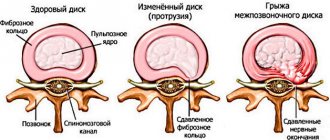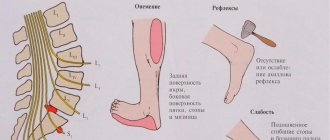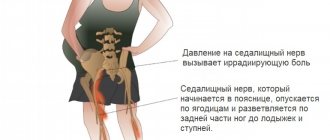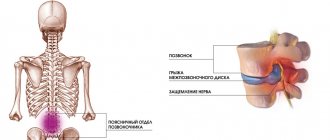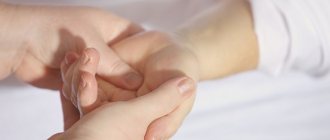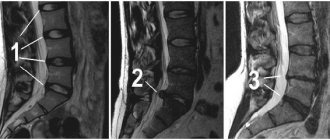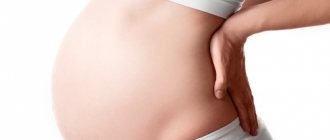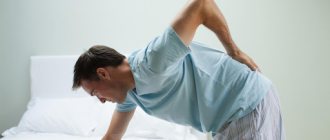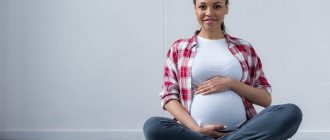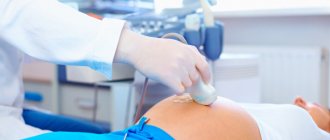A disease of the musculoskeletal system, such as an intervertebral hernia, is a protrusion of the fibrous ring beyond the intervertebral disc with further entry of its contents into the spinal canal. Many women are very concerned about the compatibility of pregnancy and intervertebral hernia. It is possible and necessary to treat the disease while waiting for the baby, but according to a special scheme. First of all, treatment should be structured in such a way as not to harm the health of the fetus.
The effect of pregnancy on the spine
During pregnancy, a woman’s body changes greatly: physiological changes, hormonal changes occur, and, starting from the second trimester, the fetus also actively grows and gains weight. Towards the end of pregnancy, a woman's skeletal system and ligamentous apparatus, under the influence of hormones, begin to prepare for childbirth: the ligaments become softer and more elastic, the bones slightly change their position - all this should help the baby to be born without problems. But all these wonderful changes expose the pregnant woman’s spine and musculoskeletal system to additional stress. And if there were problems on this side before pregnancy (for example, a woman complained of back pain, she was diagnosed with osteochondrosis, intervertebral hernia) - it is during pregnancy, during a period of increased stress on the spine, that these diseases can make themselves felt again and cause various complications during gestation, childbirth or the postpartum period.
Osteochondrosis is one of the most common diseases of the spine; according to statistics, it affects about 80 percent of the world's population, and half do not even suspect that they are sick. Protrusions can be found in approximately 50 percent of people over 30, and this is due not only to the fact that diagnostics have become more advanced, but also to a sedentary lifestyle.
Where to start and how to prepare?
- Carry out a course of treatment to prevent a sudden exacerbation.
- Select and study exercises for different trimesters of pregnancy.
- Select orthopedic accessories (bandage, chest corset, comfortable shoes).
- Think about possible reduction of stress on the spine (cleaning the apartment, working, shopping with heavy bags).
The pregnancy period is long, the tummy increases gradually and the load on the spine increases slowly. The body adapts perfectly if a woman follows all the recommended regimen, uses devices, and does exercises.
Practice shows that there is no need to be afraid of pregnancy if you have a spinal hernia. Even in the presence of chronic diseases, childbirth takes place without complications. Although in some cases a “caesarean section” may be indicated. For example, this applies to those women who have congenital problems with the pelvic bones and spine.
Intervertebral hernia
How does such a problem as intervertebral hernia occur? The reason lies in the intervertebral discs. They have no blood vessels, and nutrition comes to them directly from the tissues surrounding the spine. If for some reason the flow of nutrients is disrupted, osteochondrosis first develops: due to metabolic disorders, the disc “dries out”, its fibrous capsule delaminates and loses its strength. The neighboring vertebrae begin to put intense pressure on such a weak intervertebral disc - and the higher the load a person experiences, the stronger the pressure. As a result, the contents of the disc may be “squeezed out” beyond the spinal column. If the contents of the disc are still retained by the fibrous ring, this is called protrusion of the intervertebral disc. If the fibrous ring, which has lost its strength, is damaged, part of the contents of the disc forms an intervertebral hernia. Most often, this problem occurs in those discs on which the load is especially high - cervical and lumbar (the thoracic region suffers less often).
All these problems with the spine are usually accompanied by pain of varying degrees of intensity. After all, both protrusion and hernia cause muscle spasm, which leads to compression of blood and lymphatic vessels. The outflow of fluid from the damaged area is disrupted, and local edema forms, which compresses the nerve endings. Pain occurs.
Particularly severe pain in the back, lower back, and neck with any movement is caused by intervertebral hernias. In addition to pain, the main symptoms of a hernia include numbness of the skin of the neck, limbs, chest, pain in the joints of the arms and legs, and for lumbar hernias - pain in the lower abdomen, swelling of the lower extremities, problems with urination and defecation.
Childbirth
During childbirth, great strength and endurance are required, a process that is often difficult for a healthy woman to withstand. What are the risks for a woman in labor with a vertebral hernia?
At the time of delivery, the spine, especially the lumbar region, experiences increased stress. At the moment of pushing, the possibility of infringement increases, while:
- legs go numb;
- the functioning of the pelvic organs is disrupted;
- There is pain in the lower back.
Only a gynecologist, guided by the testimony of an orthopedist, can accurately say before giving birth whether a woman is recommended to have a cesarean section or the natural way.
Protrusion of intervertebral discs
Very often, a woman only finds out during pregnancy that she has one or another disease of the intervertebral discs. After all, protrusions, unlike hernias, can be practically asymptomatic, especially in the early stages of formation. Pain occurs only after excessive physical activity, and even then not always. However, pregnancy is precisely the condition in which a woman’s body constantly experiences increased stress. And it is at this time that an exacerbation of any diseases of the intervertebral discs can occur, and existing protrusions (which, with proper treatment and lifestyle changes, are completely reversible) can develop into intervertebral hernias. This is especially dangerous if the problem is in the lumbar region. In case of lumbar intervertebral hernia in a pregnant woman, special attention is required from doctors during pregnancy and childbirth, and here’s why.
A few rules for a young mother with a spinal hernia
Now a woman has given birth and in her arms is a precious little bag with kilograms that grow every month. Now you should gather your strength, start organizing your life and involve everyone who can help the woman. This is especially true for another culprit, with the help of which a small miracle of nature appeared. A young mother needs to learn how to lift and carry her baby correctly and safely.
When lifting a child:
- first bend your legs and squat without bending your spine;
- back straight, take the child;
- press it to your chest, straighten your legs and body.
When feeding:
- Without breaking your lower back during feeding, you need to create comfortable conditions for yourself;
- do not lean forward or lean back, press your back tightly against the back of the chair;
- There should be support under your head and lower back. This position will reduce the load on the sore spine.
When carrying a baby:
- press it to your chest;
- avoid bending, turning and twisting the spine;
- The best option is when there is a backpack with the necessary things on the back, and the child is in a small backpack in front.
When cleaning the house:
- provide the mop and vacuum cleaner with long handles and holders;
- To avoid bending while washing, place a bowl of water on a stand or stool.
When bathing a child:
- It is advisable to place the bath on a high level or kneel in front of the bath, placing something soft under them.
When walking:
- for long walks and to lift the stroller, you need to wear a corset;
- Don’t be shy and ask for help to lift the stroller if necessary.
If an exacerbation does occur, then drug treatment should be kept to a minimum. It is contraindicated for a nursing mother. It will be useful to:
- reflexology;
- massage;
- manual;
- physiotherapy.
All this has no contraindications.
From all of the above, we can draw a simple conclusion - pregnancy and spinal hernia may well “coexist” without causing inconvenience to the expectant mother.
Symptoms of the disease
- Hernias compress nerve endings, and they do not transmit impulses well - this can affect, in particular, the course of labor.
- In the second and third trimester of pregnancy, the uterus is located close to the spine, and if there are herniated intervertebral discs in this place, they negatively affect the posterior wall of the uterus, causing its hypertonicity.
- Hernias can disrupt the supply of nutrients and oxygen to the fetus: the child suffers from malnutrition and hypoxia.
- Due to pain, a pregnant woman who has intervertebral hernia is forced to move less. And this is extremely unhelpful: muscle tone decreases, the functioning of all internal organs is disrupted, in particular the pelvic organs.
- The woman constantly suffers from pain, she is tormented by mood swings, depression, and apathy. Such a reduced emotional and psychological background is very harmful for both the expectant mother and her baby.
- In the acute period, an intervertebral hernia can become one of the indications for a cesarean section: pushing in such a condition may be an impossible task.
Ideally, already at the stage of pregnancy planning, the expectant mother should undergo a spinal examination. And in any case - and if there are problems, and if there are no problems yet - she is strongly recommended to be monitored by an osteopath throughout pregnancy, as well as in the postpartum period. The fact is that a number of factors that many of us encounter every day can lead to the appearance of intervertebral protrusions and hernias. This:
- Sedentary work and sedentary lifestyle
- Trauma – birth injury or injury to the head and coccyx acquired during life (head bruises, whiplash injury from an unsuccessful fall are among them)
- Excess weight
- Scoliosis
- Intense sports, irrational loads and incorrect technique when performing sports exercises
- Poor nutrition
- Bad habits
Contraindications for exercise therapy during pregnancy
- diseases with elevated body temperature,
- nephropathy,
- preeclampsia,
- eclampsia,
- uterine bleeding,
- habitual miscarriage,
- history of stillbirth with Rh-negative factor,
- increased blood pressure,
- exacerbation of chronic diseases,
- acute general febrile and infectious diseases,
- purulent processes in any organs and tissues,
- pronounced early and late toxicosis of pregnant women,
- polyhydramnios,
- doctor's contraindications,
- risk of miscarriage,
- severe fatigue and poor health,
- impaired coordination of movements,
- concomitant diseases for which exercise therapy is contraindicated.
Treatment of spinal diseases
An experienced osteopath can already assess the condition of the spine during diagnosis and, if necessary, either provide prevention of future problems with intervertebral discs or alleviate existing problems. For example, there is an opinion that intervertebral hernia can only be dealt with through surgery. However, this is not entirely true: surgery on one injured disc will not eliminate the cause of the herniation, and sooner or later herniated disc protrusions will begin to appear in other areas of the spine. The task of the osteopath is to find and neutralize the very reason that brought the spine into such a state, the deviation that made it possible for hernias to develop. With the elimination of the cause, the body will have the opportunity to self-heal and maintain an optimal natural and healthy state on its own.
During osteopathic treatment, the osteopathic doctor:
- Eliminates the consequences of whiplash and other spinal injuries, relieves tension from the dura mater, improves its trophism
- Improves nutrition of all tissues in this area, normalizes muscle tone
- Relaxes existing tension in nerve roots, ligaments, muscles
- Normalizes the flow of lymph and blood, thereby reducing swelling
- Helps improve nutrition of intervertebral discs (with protrusion, this can lead to its complete regression)
- Reduces pain and prevents new attacks of pain.
In combination with osteopathic treatment during pregnancy, the expectant mother will be prescribed a set of exercises to relax the back and maintain its tone, as well as wearing a bandage - from what week of pregnancy this should be done, the type of belt and the time of wearing it will be determined by the doctor.
The article is located in the sections: OSTEOPATHY FOR ALL OSTEOPATHY IN GYNECOLOGY
Childbirth with a spinal hernia and delivery methods
Consultation with a gynecologist, orthopedist, neurosurgeon and neurologist if a pregnant woman has a hernia is very important before childbirth. This disease may inappropriately manifest itself during pushing during natural delivery. It is possible that pinching of the spinal nerves and their roots may occur .
In the presence of large hernias, a caesarean section may be recommended. Its signs are:
- sensations of “goosebumps”;
- numbness of the lower extremities;
- severe pain in the lumbar region.
With a hernia, women are recommended to give birth on their own in cases where the neoplasm is not large in size and the risk of pinching is low. Still, natural childbirth is much better than surgical intervention.
Delivery by caesarean section is used in extreme cases, when natural childbirth is a high risk, i.e..:
- with large intervertebral hernias;
- the hernial protrusion has an unfortunate location - directed to the lower or lateral side of the spinal canal;
- during pregnancy, the woman experienced worsening neurological symptoms resulting from the development of a hernial protrusion;
- others for pathologies that, together with a disease of the spinal column, can negatively affect the condition of the mother or unborn child.
Surgical intervention is always a last resort measure for delivery . If after the consultation the specialists agree that the woman is able to give birth naturally, they will not resort to surgery.
